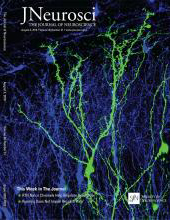- EN - English
- CN - 中文
Olfactory Habituation-dishabituation Test (Mouse)
嗅觉习惯化-去习惯化试验(小鼠)
发布: 2017年03月05日第7卷第5期 DOI: 10.21769/BioProtoc.2154 浏览次数: 9903
评审: Soyun KimEhsan KheradpezhouhEdgar Soria-Gomez
Abstract
Olfaction plays a fundamental role in the various behaviors such as feeding, mating, nursing, and avoidance in mice. Behavioral tests that characterize abilities of odor detection and recognition using genetically modified mice reveal the contribution of target genes to the olfactory processing. Here, we describe the olfactory habituation-dishabituation test for investigating the odor detection threshold in mice.
Keywords: Olfaction (嗅觉)Background
Olfactory system is a good model for studying the sensory processing in the brain. To characterize abilities of odor detection in genetically modified mice, the olfactory habituation-dishabituation test was performed using either filter paper or cotton scented with a test odor (Kobayakawa et al., 2007; Ferquson et al., 2000). There is a natural tendency of mice preferentially exploring novelty such as a novel odor and a novel object (Bevins and Besheer, 2006). Therefore, there is no training in advance before starting these tests. However, it is difficult to constantly supply the test odor especially at lower concentrations (around the detection threshold), because the odor is diluted by diffusion during the test. Here, we describe a method for the olfactory habituation-dishabituation test using an olfactometer. This method has an advantage in the point that mice are exposed to the odor at a constant concentration during the test, compared with that using the filter paper (Takahashi et al., 2016).
Materials and Reagents
- Latex gloves (NIPPON Genetics, catalog number: SLPF-M )
- Paper towels (KCWW, Kimberly-Clark, catalog number: 47000 )
- Filter tips
10 μl (FUKAEKASEI and WATSON, catalog number: 1252-207CS )
200 μl (FUKAEKASEI and WATSON, catalog number: 1252-703CS )
1,000 μl (FUKAEKASEI and WATSON, catalog number: 124-1000S ) - Laboratory-bred mice
Note: Mice are housed in groups 3-5 per cage, kept in a room with controlled temperature (~23 °C) and humidity under 12 h light/dark cycle (lights on at 8:30 AM) with ad libitum access to food and water. - Eugenol (6.3 M) (Nacalai Tesque, catalog number: 15806-42 )
- 70% ethanol
Equipment
- Olfactometer with two channels (Matsumi Kagaku Keisoku)
- Gas cylinder (normal air)
- Test cage (25 x 37 x 24 cm, polypropylene)
- Clear acrylic board (which can cover the roof of the test cage)
- Video camera (Sony, catalog number: HDR-CX560V )
Note: The mouse behavior is recorded under the weak-light condition. This model (Sony Nightshot Camcorder) is equipped with infrared-mode. - Tripod for camera
Note: The gas cylinder containing clean air is connected to the olfactometer. The olfactometer regulates the gas flow (0.5 L/min), and switches flow between clean air and air with an odor by passing the air through a bottle containing eugenol. The olfactometer, connected to the test cage (25 x 37 x 24 cm), can supply either the clean air or the odor through the gas port (0.5-mm diameter hole) on the wall (2-cm height). The roof of test cage is covered with clear acrylic board (Figure 1).
Figure 1. Apparatus of the olfactory habituation-dishabituation test
Software
- Microsoft Excel (Microsoft)
Procedure
文章信息
版权信息
© 2017 The Authors; exclusive licensee Bio-protocol LLC.
如何引用
Readers should cite both the Bio-protocol article and the original research article where this protocol was used:
- Takahashi, H. and Tsuboi, A. (2017). Olfactory Habituation-dishabituation Test (Mouse). Bio-protocol 7(5): e2154. DOI: 10.21769/BioProtoc.2154.
-
Takahashi, H., Ogawa, Y., Yoshihara, S., Asahina, R., Kinoshita, M., Kitano, T., Kitsuki, M., Tatsumi, K., Okuda, M., Tatsumi, K., Wanaka, A., Hirai, H., Stern, P. L. and Tsuboi, A. (2016). A subtype of olfactory bulb interneurons is required for odor detection and discrimination behaviors. J Neurosci 36(31): 8210–8227.
分类
神经科学 > 行为神经科学 > 认知
您对这篇实验方法有问题吗?
在此处发布您的问题,我们将邀请本文作者来回答。同时,我们会将您的问题发布到Bio-protocol Exchange,以便寻求社区成员的帮助。
提问指南
+ 问题描述
写下详细的问题描述,包括所有有助于他人回答您问题的信息(例如实验过程、条件和相关图像等)。
Share
Bluesky
X
Copy link












